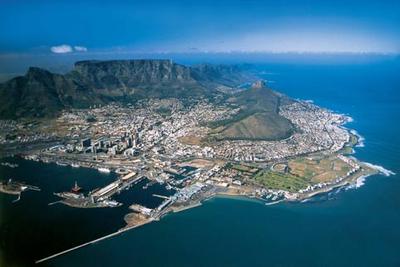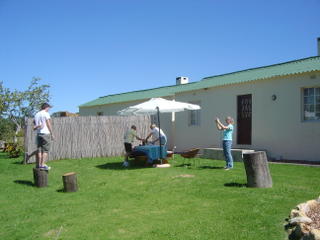Free State & Skiing
We are planning a trip to the Free State and Lesotho in the near future so this recent newspaper article is of interest.
The Free State is not a place I have ever considered as a tourist destination - visions of endless kilometres of barren landscape broken by the odd dull dorpie discouraged me from ever contemplating a holiday there - but as matters would have it I was thankfully forced into a situation to visit there.I had decided to visit the new Afriski skiing resort at Oxbow, high in Lesotho's Maluti mountains. My timing was poor. I had planned to go over the Women's Day long weekend in August only to find that most accommodation at and around Oxbow was booked out. But I found an alternative - the resort was an easy hour's drive from the eastern Free State/Lesotho border, so we could stay on the Free State side of the border and still ski. Searching for accommodation on the web, I not only found a wonderful cottage in the closest town to the border, Fouriesberg, but also learnt that the area was full of natural attractions and tourist spots. Our first stop, an easy four-hour drive from Durban, was the charming nouveau art-haven of Clarens - a tiny tree-fringed town in the middle of nowhere. The Rooiberge range towers above the village and in the distance the mighty Malutis stand proud in shades of purple and blue.We spent hours browsing in the art galleries, craft shops, eclectic clothing and furniture stores, and Basotho blanket, basket and tapestry dealers. We then rested our shopping-weary bodies at one of Clarens' restaurants, taking in the dressed stone of the town's buildings and the heady perfume of fruit tree blossoms. The menu was magnificent and my sweet tooth was in nirvana with offerings such as homemade Turkish delight, fudges and peanut brittle.Our bellies full, we then ventured into the local pub to watch the South Africa vs Australia Test; the clientele proving to be as entertaining as the rugby. And then, reluctantly, we headed out, thinking that Clarens is that rare phenomenon in the Free State: a dorp you'd actually want to hang out in.Our next stop, 30km away, was our home for the next three nights, a renovated old stone schoolhouse in Fouriesberg - a little town which served as the capital of the Free State for a spell during the Anglo-Boer War. Today, it's a fairly inconsequential place, but there's nothing non-descript about the scenery: the Malutis and the Witteberge tower over it and the setting sun seems to set the sandstone cliffs of the arid landscape on fire. That night we huddled around the braai, braving the icy evening air so that we could take in the beauty of a Free State sky, studded with an infinity of stars.At 6am the following day, bundled up warmly, we scrapped the ice off our windscreens and set off to experience skiing in Africa. After one of the most friendly border crossings I have ever experienced we were in Lesotho. Soon painted huts, locals bundled in blankets, gum boots and little else despite the dawn sub-zero temperature, sheep, sheep and more sheep, flashed by.Then it was up the hair-raisingly steep Moteng Pass, up to the mystical Mahlasela valley, at 3 322m above sea level. As the pass levelled, in the middle of the emptiness, we saw the Afriski Leisure Kingdom - a rather grand name, but then when you see its magical setting you can forgive their embellishment. We found a few ski-style chalets in various stages of completion, a bar, restaurant and a well-equipped ski-shop. We dashed past these with our eyes on the 1km-long ski slope - a strip of pure white snow amid the barren brown surroundings. There had been no natural snowfalls but Afriski, like many European resorts, produces its own snow. We kitted up at the ski shop and then headed to the slope where for the next six hours we skied non-stop. With snow spraying behind us we whizzed and weaved down, with the odd spectacular fall. There is only one slope and in a day you may descend many times. But this does not matter - every descent is exhilarating.And that is why the next day we found ourselves, driving back across the border and up the perilous pass to race down the slope again another umpteen times. By mid afternoon on our second day our screaming thigh muscles would continue no longer. We revived ourselves with gluwein in Loffie's African apres-ski bar before returning to Fouriesberg.Our last day of the holiday was spent exploring Fouriesberg's surrounds. We visited the Meiringskloof Nature reserve to see the largest sandstone overhang in the world. It was truly impressive not only for its size but also its colour - massive rock formations streaked with red, ochre and gold. Our route then took us to our last stop - the Golden Gate National Park, so named from the brilliant shades of gold cast by the sun on the cliffs, especially the Brandwag rock, keeping vigil over the main rest camp. The park is spectacular, encompassing wide-open mountain country. Although eland, blesbok, springbok, zebra, mountain reedbuck and black wildebeest roam the hillsides, the real attraction is the unfettered space, eroded sandstone bastions and seamless blue skies.
The Free State is not a place I have ever considered as a tourist destination - visions of endless kilometres of barren landscape broken by the odd dull dorpie discouraged me from ever contemplating a holiday there - but as matters would have it I was thankfully forced into a situation to visit there.I had decided to visit the new Afriski skiing resort at Oxbow, high in Lesotho's Maluti mountains. My timing was poor. I had planned to go over the Women's Day long weekend in August only to find that most accommodation at and around Oxbow was booked out. But I found an alternative - the resort was an easy hour's drive from the eastern Free State/Lesotho border, so we could stay on the Free State side of the border and still ski. Searching for accommodation on the web, I not only found a wonderful cottage in the closest town to the border, Fouriesberg, but also learnt that the area was full of natural attractions and tourist spots. Our first stop, an easy four-hour drive from Durban, was the charming nouveau art-haven of Clarens - a tiny tree-fringed town in the middle of nowhere. The Rooiberge range towers above the village and in the distance the mighty Malutis stand proud in shades of purple and blue.We spent hours browsing in the art galleries, craft shops, eclectic clothing and furniture stores, and Basotho blanket, basket and tapestry dealers. We then rested our shopping-weary bodies at one of Clarens' restaurants, taking in the dressed stone of the town's buildings and the heady perfume of fruit tree blossoms. The menu was magnificent and my sweet tooth was in nirvana with offerings such as homemade Turkish delight, fudges and peanut brittle.Our bellies full, we then ventured into the local pub to watch the South Africa vs Australia Test; the clientele proving to be as entertaining as the rugby. And then, reluctantly, we headed out, thinking that Clarens is that rare phenomenon in the Free State: a dorp you'd actually want to hang out in.Our next stop, 30km away, was our home for the next three nights, a renovated old stone schoolhouse in Fouriesberg - a little town which served as the capital of the Free State for a spell during the Anglo-Boer War. Today, it's a fairly inconsequential place, but there's nothing non-descript about the scenery: the Malutis and the Witteberge tower over it and the setting sun seems to set the sandstone cliffs of the arid landscape on fire. That night we huddled around the braai, braving the icy evening air so that we could take in the beauty of a Free State sky, studded with an infinity of stars.At 6am the following day, bundled up warmly, we scrapped the ice off our windscreens and set off to experience skiing in Africa. After one of the most friendly border crossings I have ever experienced we were in Lesotho. Soon painted huts, locals bundled in blankets, gum boots and little else despite the dawn sub-zero temperature, sheep, sheep and more sheep, flashed by.Then it was up the hair-raisingly steep Moteng Pass, up to the mystical Mahlasela valley, at 3 322m above sea level. As the pass levelled, in the middle of the emptiness, we saw the Afriski Leisure Kingdom - a rather grand name, but then when you see its magical setting you can forgive their embellishment. We found a few ski-style chalets in various stages of completion, a bar, restaurant and a well-equipped ski-shop. We dashed past these with our eyes on the 1km-long ski slope - a strip of pure white snow amid the barren brown surroundings. There had been no natural snowfalls but Afriski, like many European resorts, produces its own snow. We kitted up at the ski shop and then headed to the slope where for the next six hours we skied non-stop. With snow spraying behind us we whizzed and weaved down, with the odd spectacular fall. There is only one slope and in a day you may descend many times. But this does not matter - every descent is exhilarating.And that is why the next day we found ourselves, driving back across the border and up the perilous pass to race down the slope again another umpteen times. By mid afternoon on our second day our screaming thigh muscles would continue no longer. We revived ourselves with gluwein in Loffie's African apres-ski bar before returning to Fouriesberg.Our last day of the holiday was spent exploring Fouriesberg's surrounds. We visited the Meiringskloof Nature reserve to see the largest sandstone overhang in the world. It was truly impressive not only for its size but also its colour - massive rock formations streaked with red, ochre and gold. Our route then took us to our last stop - the Golden Gate National Park, so named from the brilliant shades of gold cast by the sun on the cliffs, especially the Brandwag rock, keeping vigil over the main rest camp. The park is spectacular, encompassing wide-open mountain country. Although eland, blesbok, springbok, zebra, mountain reedbuck and black wildebeest roam the hillsides, the real attraction is the unfettered space, eroded sandstone bastions and seamless blue skies.







